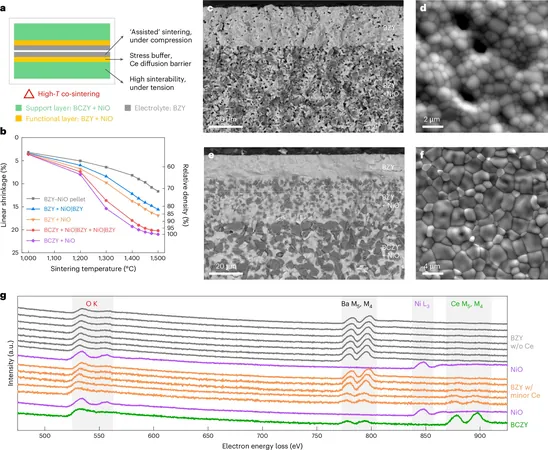
Revolutionary Breakthroughs Transform Hydrogen Production and Clean Energy Storage!
2025-05-12
Author: Wei Ling
Unleashing the Future of Hydrogen: Game-Changing Research from Oklahoma!
In an electrifying leap forward, researchers at the University of Oklahoma are transforming the landscape of clean energy with groundbreaking advancements in protonic ceramic electrochemical cells (PCECs). These innovative technologies promise to solve critical challenges in efficiency and manufacturing, paving the way for reliable and affordable hydrogen production.
Led by the brilliant Dr. Hanping Ding, an assistant professor in the School of Aerospace and Mechanical Engineering, the team has produced two cutting-edge studies that could redefine energy solutions.
Say Goodbye to Old Limitations!
Historically, PCECs have struggled to keep up with the extreme demands of commercial use, primarily due to their reliance on cerium-based materials, which often fail under intense heat and steam. In a remarkable study published in Nature Synthesis, Ding and his team introduced a revolutionary method of creating pure barium zirconate-based electrolytes. This breakthrough allows for record-low operating temperatures, ensuring stability and efficiency even in the most challenging electrochemical conditions.
Next-Level Electrodes: Speed Meets Efficiency!
But that’s not all! In a second pivotal study featured in Nature Communications, Ding’s research team, including graduate student Shuanglin Zheng, developed an ultra-porous nano-architecture electrode designed to transport electrons, oxygen ions, and protons with unprecedented speed and efficiency. This new technology significantly enhances the cells' performance under heavy usage and spotlight the importance of optimizing electrode microstructures.
"These findings represent significant advancements in high-temperature steam electrolysis," remarked Ding. "We are unlocking the full potential of PCECs for sustainable energy applications by addressing key challenges in both electrolyte processing and electrode design."
A Bright Future for Clean Energy!
These dual breakthroughs not only advance the capabilities of PCECs in hydrogen production but also shine a light on their potential in power generation and chemical manufacturing. Ding’s findings are expected to resonate across multiple technologies, improving alkaline fuel cells, water electrolyzers, and biosensors.
The implications of this research signify a meaningful step toward a greener future, showcasing the University of Oklahoma’s growing influence in energy innovation and commitment to fostering next-generation systems that could greatly reduce emissions and promote sustainable energy sources globally.




 Brasil (PT)
Brasil (PT)
 Canada (EN)
Canada (EN)
 Chile (ES)
Chile (ES)
 Česko (CS)
Česko (CS)
 대한민국 (KO)
대한민국 (KO)
 España (ES)
España (ES)
 France (FR)
France (FR)
 Hong Kong (EN)
Hong Kong (EN)
 Italia (IT)
Italia (IT)
 日本 (JA)
日本 (JA)
 Magyarország (HU)
Magyarország (HU)
 Norge (NO)
Norge (NO)
 Polska (PL)
Polska (PL)
 Schweiz (DE)
Schweiz (DE)
 Singapore (EN)
Singapore (EN)
 Sverige (SV)
Sverige (SV)
 Suomi (FI)
Suomi (FI)
 Türkiye (TR)
Türkiye (TR)
 الإمارات العربية المتحدة (AR)
الإمارات العربية المتحدة (AR)